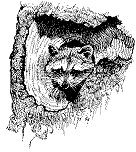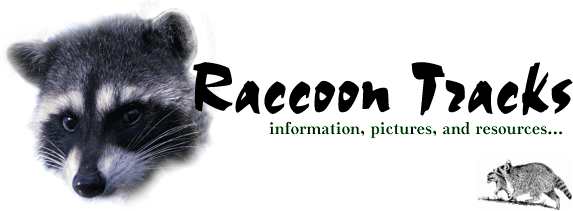|
EARLY ACCOUNT OF RACCOONS IN AMERICA
An early account of raccoons in America can be seen in A New Voyage to the Carolinas
(1709) [12] by John Lawson (d. 1711), British Surveyor-General of North Carolina. The
sub-title of Lawson's book is "Containing the Exact Description and Natural
History of that COUNTRY: Together with the Present State thereof. And A JOURNAL Of
a Thousand Miles, Travel'd thro' several Nations of INDIANS. Giving a particular
Account of their Customs, Manners, &c." John Lawson -- "Gent[leman].
Surveyor-General of North Carolina" -- presented his qualifications to enlighten
us about the raccoon, by informing his original readers -- the eighteenth century,
British lords and proprietors of the Province of Carolina in America -- that there
was a lack of educated observers to  record
their observations, and that he -- a Gentleman -- has been opportunely situated to
travel to North Carolina to make such observations for their benefit: "'Tis
a great Misfortune, that most of our Travellers, who go to this vast Continent in
America, are Persons of the meaner Sort, and generally of a very slender Education;
who being hir'd by the Merchants, to trade amongst the Indians, in which Voyages
they often spend several Years, are yet, at their Return, uncapable of giving any
reasonable Account of what they met withal in those remote Parts; tho' the Country
abounds with Curiosities worthy a nice Observation... In the Year 1700, when People
flock'd from all Parts of the Christian World, to see the Solemnity of the Grand
Jubilee at Rome, my Intention, at that Time, being to travel, I accidentally met
with a Gentleman, who had been Abroad, and was very well acquainted with the Ways
of Living in both Indies; of whom, having made Enquiry concerning them, he assur'd
me, that Carolina was the best Country I could go to; and, that there then lay a
Ship in the Thames, in which I might have my Passage." record
their observations, and that he -- a Gentleman -- has been opportunely situated to
travel to North Carolina to make such observations for their benefit: "'Tis
a great Misfortune, that most of our Travellers, who go to this vast Continent in
America, are Persons of the meaner Sort, and generally of a very slender Education;
who being hir'd by the Merchants, to trade amongst the Indians, in which Voyages
they often spend several Years, are yet, at their Return, uncapable of giving any
reasonable Account of what they met withal in those remote Parts; tho' the Country
abounds with Curiosities worthy a nice Observation... In the Year 1700, when People
flock'd from all Parts of the Christian World, to see the Solemnity of the Grand
Jubilee at Rome, my Intention, at that Time, being to travel, I accidentally met
with a Gentleman, who had been Abroad, and was very well acquainted with the Ways
of Living in both Indies; of whom, having made Enquiry concerning them, he assur'd
me, that Carolina was the best Country I could go to; and, that there then lay a
Ship in the Thames, in which I might have my Passage."
In a list of twenty-seven animals native to North Carolina in 1700, John Lawson lists
the "raccoon" in the middle of that list. Under the heading of "Raccoon,"
Lawson records the following:
"The Raccoon is of a dark-gray Colour; if taken young, is easily made tame,
but is the drunkenest Creature living, if he can get any Liquor that is sweet and
strong. They are rather more unlucky than a Monkey. When wild, they are very subtle
in catching their Prey. Those that live in the Salt-Water, feed much on Oysters which
they love. They watch the Oyster when it opens, and nimbly put in their Paw, and
pluck out the Fish. Sometimes the Oyster shuts, and holds fast their Paw till the
Tide comes in, that they are drown'd, tho' they swim very well. The way that this
Animal catches Crabs, which he greatly admires, and which are plenty in Carolina,
is worthy of Remark. When he intends to make a Prey of these Fish, he goes to a Marsh,
where standing on the Land, he lets his Tail hang in the Water. This the Crab takes
for a Bait, and fastens his Claws therein, which as soon as the Raccoon perceives,
he, of a sudden, springs forward, a considerable way, on the Land, and brings the
Crab along with him. As soon as the Fish finds himself out of his Element, he presently
lets go his hold; and then the Raccoon encounters him, by getting him cross-wise
in his Mouth, and devours him. There is a sort of small Land-Crab, which we call
a Fiddler, that runs into a Hole when any thing pursues him. This Crab the Raccoon
takes by putting his Fore-Foot in the Hole, and pulling him out. With a tame Raccoon,
this Sport is very diverting. The Chief of his other Food is all sorts of wild Fruits,
green Corn, and such as the Bear delights in. This and the Possum are much of a Bigness.
The Fur makes good Hats and Linings. The Skin dress'd makes fine Womens Shooes."
Further, Lawson writes in his "A New Voyage to the Carolinas" that: (1)
Raccoons are tree climbers, like the possum, i.e., "They [possums] climb Trees,
as the Raccoons do." (2) Raccoons are "bold Thieves," like the minx
("an Animal much like the English Fillimart or polcat"), taking the eggs
of the tortoise out of the sand. (3) Raccoons are able to be made tame, unlike the
North Carolina fox, i.e., "When hunted, they [the foxes of North Carolina] make
a sorry Chace, because they run up Trees, when pursued. They are never to be made
familiar and tame, as the Raccoon is." (4) Raccoons are consumers of the fiddler
crab, i.e., "Fidlars are a sort of small Crabs, that lie in Holes in the Marshes.
The Raccoons eat them very much. I never knew any one try, whether they were good
Meat or no." (5) Raccoons are listed by Lawson as "Indian Food." (5)
Raccoons are killed and their pelts are used for Indian clothing, i.e., "Their
Feather Match-Coats are very pretty, especially some of them, which are made extraordinary
charming, containing several pretty Figures wrought in Feathers, making them seem
like a fine Flower Silk-Shag; and when new and fresh, they become a Bed very well,
instead of a Quilt. Some of another sort are made of Hare, Raccoon, Bever, or Squirrel-Skins,
which are very warm." (6) Raccoons constitute one of the chief sources for clothing
of the Hatteras Indians, i.e., "The Dresses of these People are so different,
according to the Nation that they belong to, that it is impossible to recount all
the whimsical Figures that they sometimes make by their Antick Dresses. Besides,
Carolina is a warm Country, and very mild in its Winters, to what Virginia, Maryland,
Pensylvania, New-York, the Jerseys, and New-England are; wherefore, our Indians Habit
very much differs from the Dresses that appear amongst the Savages who inhabit those
cold Countries; in regard their chiefest Cloathing for the Winter-Season is made
of the Furs of Bever, Raccoon, and other Northern Furs, that our Climate is not acquainted
withal, they producing some Furs, as the Monack, Moor, Marten, Black Fox, and others
to us unknown."
back home

Copyright © 2005 Raccoon Pictures & Facts
While this website has no affiliation with Havahart®, the
humane treatment of animals is encouraged!
Member of Fohn.net
|
